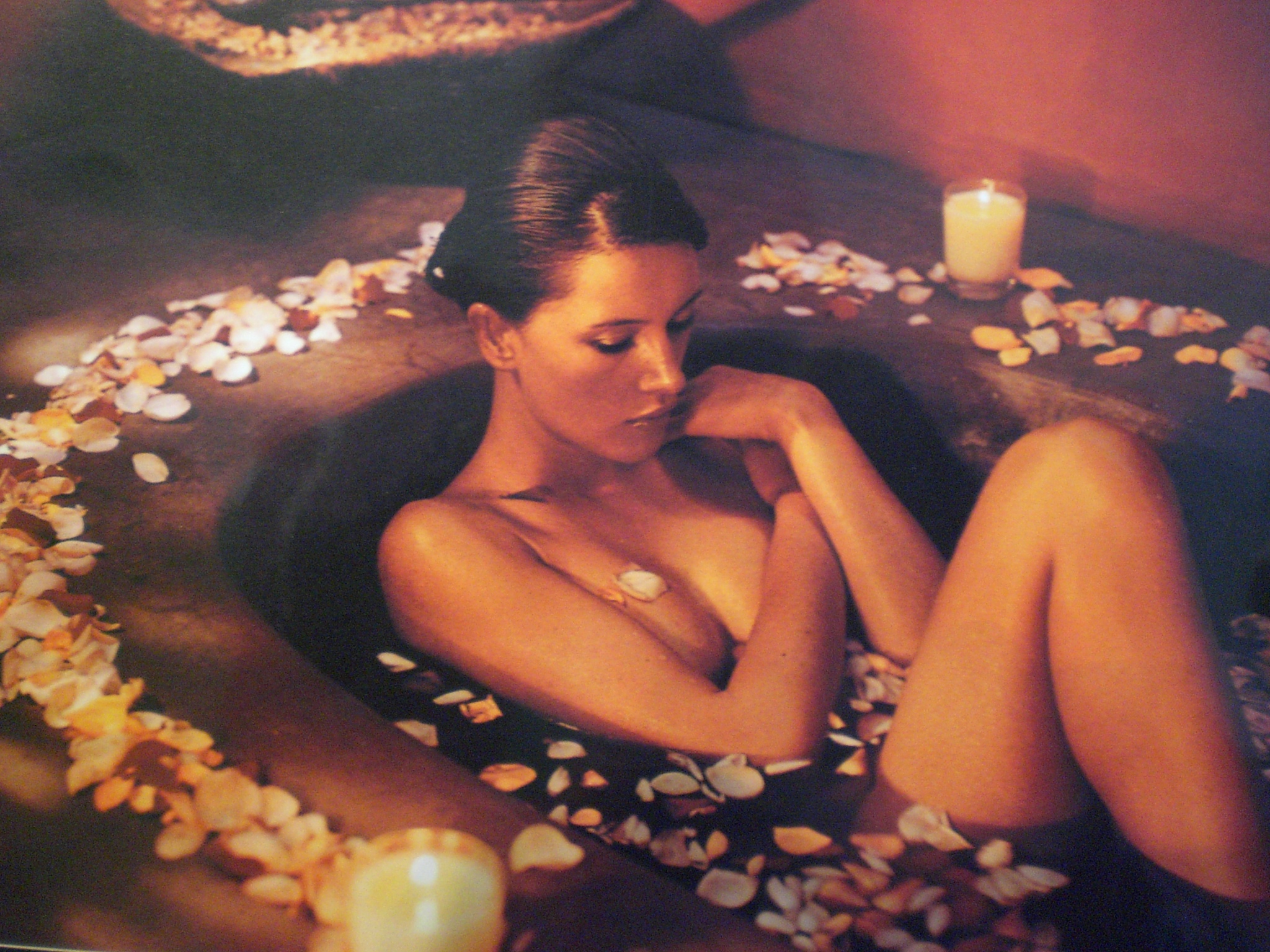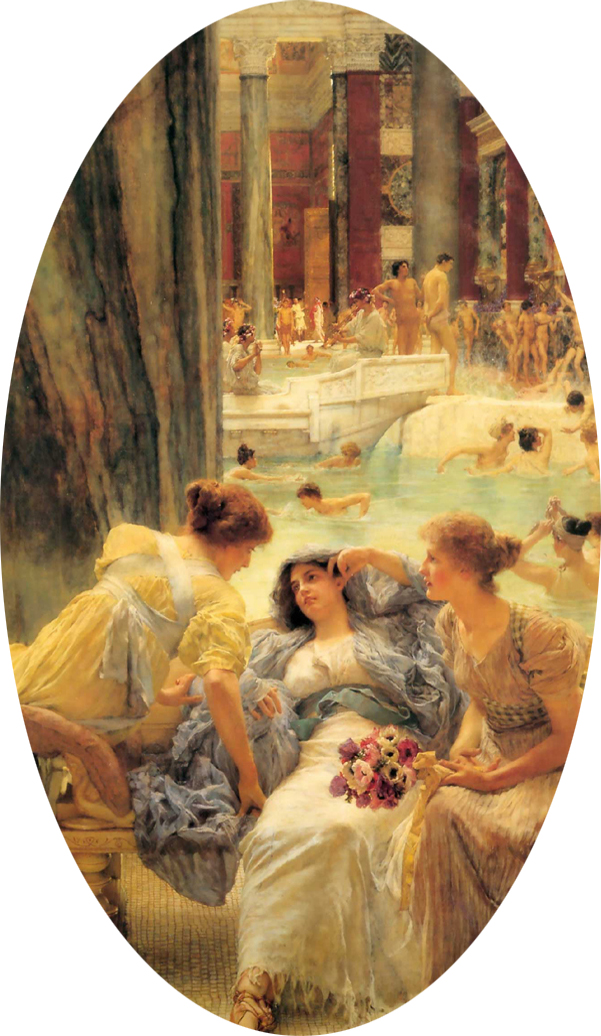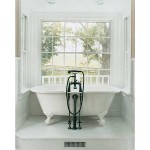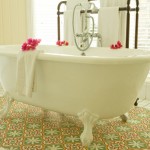Changing the Colour of a Bath
We can change the colour of your bath. Or restore the colour of an existing bath that has gotten worn or damaged.
Generally the colour required is made on-site, matching it to an existing coloured fixture. This is quite a time consuming process so it adds a little bit to the price compared to restoring a bath to white.
If you don’t require or need you bath resurfaced to match existing fixtures, but just want it coloured (for example, someone requested their bath be resurfaced in black) then the colour can be obtained ready made and this brings costs down.

If you have a roll-top style of bath, then usually the outside of the bath is painted, often in a strong, bold colour. The specialist materials we use for the inside of the bath are not required, although if we do the outside for you in white we will use these materials.
This is something you can do yourself as the finish on the outside is not as critical as on the inside. After all, you are not going to be sitting, naked, on the outside. Nor is it going to be getting immersed in water.
If you do plan on doing the outside yourself, I’d recommend not using a high gloss finish as the outside of a cast iron bath is often quite rough and pitted and a glossy finish will just highlight this. A satin finish should look much better.
Also, doing the feet in a different colour helps to draw attention to them, and if you have clawed feet or the like (some of these baths can have quite impressive feet with a surprising amount of detail) then a different colour is really worth considering.
Or, if you prefer, we can do it for you.
Services include:Bath Re-enamelling bath chip repairs, bathroom suite, enamelling, bathroom renovation, re-enamelling a bath, resurfacing, bath re-surfacing,enamel repairs,chipped enamel, cast iron bath, bathtub refinishing, bath tub resurfacing,
When Should One Look at Having a Bath Resurfaced
Bath tub refinishing, Bath tub Resurfacing
The majority of the baths we resurface are done because the bottom area of the bath has become dull, rough stained and hard to clean. These are, almost all of them, cast-iron baths.
Pressed-steel baths and plastic/acrylic don’t usually have this problem to the same degree because their finish is tougher and more resistant to chemical attack by modern cleaners, acidic water and so on.However they can become patchy and look bleached as well as suffer from lime-scale and off course they can be chipped or damaged in some way. As far as repairing a bath is concerned we do more repairs to pressed steel and plastic baths but not so many repairs to cast iron bath.
We also get asked to do baths to handle things like chips in the bath or to change the colour of a bath or cover in tap holes when taps have been moved (onto the wall, for instance).
We do also resurface some pressed-steel and plastic baths, particularly when removing them would result in expensive redecoration. Pressed-steel baths are prone to chipping but apart from that they usually last very well. They can become discoloured and a bit rough. Once in a while you come across one that has had damage done due to corrossive cleaning agents, but compared to cast-iron baths this is relatively rare.
So of the pressed-steel and plastic baths we resurface, the main reason for resurfacing tends to be to change the colour (currently the trend is to get a coloured bath changed to white) or to give the coloured bath a new lease of life.
Resurfacing versus replacement?
I suppose as it’s my business I ought to say it’s better to resurface. However, I think there is a valid case for both depending on what kind of bath you have and where it is fitted in the bathroom. Also it depends on what you are planning to do with your bathroom. Another factor is what will be what is the most cost effective. And finally there is the age of your home.
For example, if you are planning to completely change around you bathroom, moving the fixtures and so on, I would replace the bath if it is a pressed steel or plastic bath, as these are quite inexpensive, easy to get hold of, and you are already going to be redoing the plumbing, plastering, tiling and so on.
If you have a cast iron bath then it may be more sensible to keep it and get it resurfaced, especially if it is a roll-top or 1930’s style of bath. These are not easy to replace and costly to buy even second-hand and are very desirable. If you are planning to get rid of a roll-top, then don’t throw it out. Sell it! People want these.
If you have one of the plainer cast iron baths from the 1950s or ’60s (these baths are usually large and boxed in) and you are planning to completely change around your bathroom then you may well be better to replace it with a plastic or pressed steel bath. I think in this instance it comes down to personal preference. Some people like the fact that a cast iron bath feels substantial when they are in it and these baths tend to be a bit deeper and wider. Others like the modern designs you can get with plastic baths. If you are a bit bigger like myself then a cast iron bath is a must have. But as i said it is down to personal preferences.
If you just want your existing bath to look better and are not planning to change things around in the bathroom (and this is the scenario in the majority of the jobs we do) then resurfacing becomes a good option because it will generally be cheaper, easier to organize and the bath will be out of commission for a shorter period of time (with us you will be able to use the bath the next day).
But even in this scenario, if you live in a modern house, it may be as cheap or cheaper to replace your existing plastic bath as it will be a standard size which is easy to get hold of and not expensive. It should be quite straight-forward for a plumber to change the baths around so his costs will not be great. You shouldn’t need to re-tile as the new bath ought to slot right in where the old one was.
But even with new-build houses there are exceptions. I recently did a plastic bath in a new-build flat for a single guy. He wanted it resurfaced because he worked all week and didn’t want the hassle of trying to source a new bath and organising a plumber and having to take a day off work to let the plumber in. As I was willing to work on a Saturday then resurfacing, for him, was a better option.
If you are not sure what would be best for yourself in terms of resurfacing you bath or replacing it, please feel free to e-mail me and I’ll do my best to help you out.

The Bath Business –
Repairing chips in a bath
We can repair chips in a bath. If the bath itself is in pretty good condition and just has a chip or two, then rather than having the whole bath done, the chip itself can be fixed. It is cheaper than resurfacing the whole bath. This repair service works best on a relatively new bath where one or two chips exist. Also we can repair small cracks or holes in the bath.
I wouldn’t recommend doing a chip repair if the bath is starting to feel a bit worn and rough, especially if the chip is in the worn area. The area repaired will have a different texture to the surrounding area and as the old surface is rough it will tend be hard to clean and discolour, making the repair very noticeable.
Another point to make in relation to chip repairs is that even if your bath is white, we will still need to colour match the repaired area to the existing bath otherwise you have two different shades of white right next to each other and the repair stands out like a sore thumb.
Probably the majority of repairs we do are on pressed steel baths, as these are especially prone to being chipped.
What Kinds of Baths Can Be Resurfaced
- At January 22, 2009
- By
- In bath chip repairs london / bath enamel / bath re-enameling UK / bath re-enamelling UK / bath re-surfacing edinburgh / bath re-surfacing london / bath renovation london / bathroom renovation / Bathrooms london / chipped enamel / enamel repairs / enamelling / shower re-surfacing
There are three main materials baths are made from: Cast-iron, Pressed steel and plastic/Acrylic.
We can resurface all of these.
CAST IRON BATHS.Cast iron is what baths have traditionally been made from. Baths have been made this way for a long time so you come across many different styles from Victorian roll-top baths with clawed feet, 1930’s art-deco style with broad, square shoulders and boxed in with cast-iron panels in matching colour (the most common colour of these baths is green/avocado) through to the much plainer baths of the fifties and sixties which are boxed in with panels made from ply or the like. Then as you get into the 70’s and 80’s you come across baths where the enamel is coloured again, the baths often have handles and again, usually the are boxed in. The baths themselves are heavy. They do not flex when you get in them. A cast iron bath is very good at retaining the heat from the hot water. So a long soak in a deep cast iron bath is very desirable.We do resurface these baths regularly.
PRESSED STEEL BATHS. These baths are quite common today and are often still used in new-build houses. Generally they look very similar to cast iron baths from the fifties and sixties but are much thinner and lighter. If you rap them with your knuckle you can hear a “ring” from a pressed-steel bath which you won’t get from a cast-iron bath. Usually they are boxed-in. A pressed steel bath is quite easy to transport so, as mentioned earlier, it is quite popular to fit this kind of bath in a new build. We do resurface pressed steel baths.
PLASTIC/ACRYLIC BATHS. Very common from the seventies through to the present. A lot of the bathroom suites you see with strong colours such as burgundy, blue, mustard, green and so on tend to (but no always) have plastic baths. Also these baths tend to come in a wider variation of shapes than the cast or pressed steel baths. You can easily have a reproduction Victorian Roll top made from acrylic or you can have a luxury jacuzzi bath. It is a versatile material. This kind of bath is also very light and easy to install therefor. It can be damaged in transit or whilst fitting. We get called out to repair these fairly frequently.
These baths flex more when you use them and have a layer of plywood or chipboard under the base of them to stiffen and add strength.
A modern trend with plastic baths is to make them from much thicker material so they don’t flex and to do them in a roll-top style rather than boxed in, so you see the outside and feet of the bath.
Bathrooms Sell Houses
Bathtub refinishing, Bath tub resurfacing upgrade bathroom to sell home
Bathrooms have lost their plain utility status and are fast becoming a deal maker or breaker in real estate sales. In the current economic climate it is well worth while investing some time and money restoring or improving your bathroom. And if you decide to stay put all the better.The reasons are not hard to find says Martin Schultheiss, CEO of the Homenet estate agency group.
“It all started with the retreat of homeowners into their private space — a trend known as ‘cocooning’ in the lifestyle industry.

“The trend has gathered momentum as the pace of modern life speeded up and consumers started expressing a need to relax at home, and in keeping with this the bath ritual has gained a faithful following with an attendant emphasis on the layout, finishes and fixtures of the bathroom. Although a lot of people do shower rather than bath most of the time, they still want the option of having a luxurious bath. And anyone with a young family will want to retain a family bath. “Indeed, many prospective homeowners now attach as much value to bathrooms as they have previously attached to functional and stylish kitchens.
“The trend is very evident in new developments where bathrooms can be baronial or resemble Roman spas, to say the least. And while that may not be encouraging news to owners who want to market older properties with functional bathrooms there is much that can be done to spruce up the look and feel of older bathrooms. Ideas that will not cost much, but will add value to the home and enjoyment to daily ablutions include:
* Replacing outdated floor and wall tiles as well as countertops while choosing co-ordinated materials that will tie the whole room together and create a more spacious look.
* Untiled wall surfaces can be painted in a light,fresh colour to enhance the new scheme.
* Large mirrors with clean lines above the vanity unit or on a blank wall will further increase the illusion of space.
* Baths and basins that have seen better days can be re-enamelled at reasonable cost.
* Tired old light fittings, taps and towel rails can be replaced with sleek alternatives.
The Bath is back in Vogue

The Bath is back in Vogue
Bath Restoration and Renovation in the UK
· Supersized and spacious

Focal point

· Shower feature
· Mosaic

· Wood
· Equilibrium
Renovating your Bathroom
Renovating your Bathroom
Bath Renovations and restorations in London and Edinburgh

Above is a relatively small bathroom which has been very well designed to accommodate a very luxurious look.
Plans
1. Standard Bathroom:
2. Guest Toilet:
3. Master Bathroom:
Fitting and Fixtures
The Bath Business. Bath Re-enamelling & Re-surfacing
Beautiful Baths – The Bath Business
Back in the day, a bath in a home was considered an item of luxury and was only found in hotels and the homes of the rich and famous. But today, a bath tub is an integral part of most homes, so much so that many homes have more than just one. In addition to being highly functional and allowing you to be clean, it also makes for a wonderful place to relax. They come in a variety of types to suite every home.

Built in Baths
These are very popular in most homes and come in various shapes, sizes and materials. They are enclosed onthree sides and open only on the front side. Drop in baths are built into the floor and are at ground level. Another example of a built in bath is a corner bath.
Freestanding Baths
As the name suggests the bath stands freely in the bathroom and works best in a bigger bathroom. The taps are usually mounted onto the side on the bath or on the wall. The most popular types of freestanding baths are Clawfoot and Pedestal.Freestanding baths generally are very versatile. They can be placed in the middle of the room or against a wall. There are also a variety of styles both modern and traditional, although, most people commonly think of a traditional roll top bath when they are thinking of a free standing bath.

Shower Baths
Shower baths are typically found in smaller bathrooms as they combine the two functions while saving the homeowner space. Some large freestanding baths could also have a shower hood attached to the bath. This is called a canopy bath. These baths generally were fitted in quite large properties and could be quite an impressive centre piece to a bathroom. They are rare now but are still found. We have restored a few of them.
Speciality Baths
A spa bath or jet bath will help turn your bathroom into a sanctuary of health and relaxation. Tension and stress is melted away by jets of water massaging your body and in turn reduces muscle and joint aches and pains, therefore relaxing, mind body and soul. In recent years, spa baths have become more affordable, with more manufacturers of the product encouraging healthy competition. Spa baths are available in various shapes, sizes and number of jets, so be careful to check these when comparing prices.
Types of Baths
Bath tubs come in an assortment of materials with unique properties that affect the distinct advantages and disadvantages.
Acrylic: Fibreglass is used as a reinforcement material to the vacuum-formed acrylic sheets. This makes the finished product resistant to cracking. They can still get chipped or even look like dents have been taken out of them. However these can be repaired. Acrylic baths are lightweight and relatively inexpensive.
Cast Iron: These baths are among the most expensive baths on the market. Cast Iron baths are made by pouring molten iron into a mould. They are impervious to most chemicals and are almost impossible to dent or scratch.The enamel however can be chipped and if chipped badly the client can be left with an unsightly spot where the original iron is showing through. This can be repaired by a reputable company
Cultured Marble: are not made from marble at all, they are made by mixing limestone with a polyester resin and then finished with a gel coat. The finished product resembles natural marble in appearance. Cultured marble baths are less expensive than cast iron, but more expensive than acrylic.
Solid Surface: Solid surface materials have been used for years as an alternative to natural stone, such as marble and granite, but only recently has it gained popularity in the manufacturing of baths. The material has excellent thermal properties and will maintain the bath water temperature for longer than most other materials.
The trend is towards squared-off basin design, but for baths the bigger the better, try for a bath size of at least 1 700mm.
If you enjoy a bath for two install the bath taps on the wall next to the bath, in this way two people can share the bath comfortably. As the bath is the largest fitting in the bathroom, choose a bath in a design and style that complements the rest décor in your home.
The Bath Business – Restoring Baths to Beautiful Standards
Services include: bath re-enamelling, bath chip repairs, bathroom suite, enameling, enamelling, bathroom renovation, re-enameling, resurfacing, bath re-surfacing, enamel repairs, chipped enamel, cast iron bath, bathtub refinishing, bath tub resurfacing,
Welcome to the Bath Business’s Blog
- At January 13, 2009
- By
- In bath chip repairs london / bath enamel / bath re-enameling UK / bath re-enamelling UK / bath re-surfacing edinburgh / bath re-surfacing london / bath renovation london / bathroom renovation / Bathrooms london / chipped enamel / enamel repairs / enamelling / shower re-surfacing / the bath business
Uk’s Professional Bath Restoration company
We specialize in bath re-enamelling, bath chip repairs, bathroom suite restoration, bathroom renovation, re-enameling, resurfacing, bath and basin repairs, chip repairs bath re-surfacing, enamel repairs, chipped enamel. We have been resurfacing baths since 1986.
The main service we deliver is the restoring of baths to their original condition. We do this in-situ without disturbing existing tiling and/or decoration. We also sell original antique French and English baths and basins as well as original antique taps and other fine sanitary ware.
In Scotland we service the areas of Edinburgh, Glasgow, Melrose, Hawick (The Scottish Borders) and as far north as Aberdeen. In England we operate in London the South East primarily although we are also in Manchester and the north west of England. We cover areas such as London, Brighton, Hove, Gatwick, Surrey, Sussex, Manchester, Birmingham, Liverpool, Bath, Bristol and all surrounding areas.
Services include: bath-re-enamelling, Chip repairs, Bathroom Suite Resurfacing, enamelling, bathroom renovation, re-enamelling, resurfacing, bath re-surfacing, enamel repairs, chipped enamel, cast iron bath, bathtub refinishing, bath tub resurfacing,






























 Add us to your circle
Add us to your circle